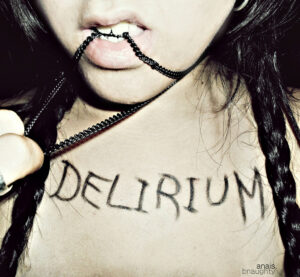Chapter 10: Neurocognitive Disorders
Delirium

Criteria to Diagnose: Delirium is a state where an individual cannot focus, the environment is “misperceived” and thoughts are disorganized (American Psychological Association, 2022). Individuals may experience hallucinations or other changes to their vision, memory impairment, or trouble with language. Delirium starts quickly and varies over time; it can be caused by many conditions ranging from infections to seizures to substance abuse (Black & Grant, 2014).
Typical Demographics: Delirium is most common among older patients, older than 70 years. Medication side effects account for roughly 39% of cases (Echeverria et al., 2022).
Treatment, Medications, and Therapies: Supportive care is a good way to treat delirium, addressing physical symptoms and any triggers that may exist. Medication may cause the delirium, so ask medical professionals for guidance on medications that help and do not cause these symptoms. In addition, there are some coping strategies that can be completed to manage or treat this condition like: good sleep habitat, meditation, promote routine and healthful habits (Mayo Clinic, 2022).
Case Studies to Review:
- The one-two punch of delirium and dementia during the COVID-19 pandemic and beyond (2020)
- Delirium during recovery in patients with severe COVID-19: Two case reports (2020)
- Delirium and the risk of developing dementia: A cohort study of 12949 patients. (2022)
Major and Mild Neurocognitive Disorders
Criteria to Diagnose: This disorder is acquired when an individual experiences significant cognitive decline. The individual will experience challenges in attention, executive function, learning and memory, language, motor abilities and social cognition (Black & Grant, 2014). The deficits will interfere with independence and normal functioning but are not classified as delirium or another mental disorder.

Typical Demographics: It is estimated that mild disorders are prevalent in 20.3% of the population, similar ratings in between male and female, but significantly higher in advanced age (Luck et al., 2017) Major neurocognitive disorder prevalence is very low until age 85, when it is roughly 30%.
Treatment, Medications, and Therapies: There is no cure for these disorder. But there are opportunities with medications like antidepressants and antipsychotics, that may minimize the symptoms. Different forms of therapy like cognitive stimulation and deep brain stimluation are alternative options that may also help manage the disorder (Lumen).
Case Studies to Review:
- Current approaches to diagnosing and treating major neurocognitive disorder (2017)
- Dementia and major neurocognitive disorders: Some lessons learned one century after the for Alois Alzheimer’s clinic notes (2021)
- Cannabinoids in the management of behavioral, psychological, and motor symptoms of neurocognitive disorders: A mixed studies systematic review (2022)
- Persistent COVID-19 associated neurocognitive symptoms in non-hospitalized patients (2021)
References:
American Psychological Association (2022). Delirium. APA. Retrieved on August 25, 2022 from https://dictionary.apa.org/delirium
Bahji, A., Breward, N., Duff, W. et al. (2022) Cannabinoids in the management of behavioral, psychological, and motor symptoms of neurocognitive disorders: a mixed studies systematic review. J Cannabis Res 4, 11. https://doi.org/10.1186/s42238-022-00119-y
Black, D. W., & Grant, J. E. (2014). DSM-5® Guidebook : The Essential Companion to the Diagnostic and Statistical Manual of Mental Disorders, Fifth Edition: Vol. Fifth edition. American Psychiatric Association Publishing.
Echeverria, M., Schoo, C., & Paul, M. (2022). Delirium. National Library of Medicine. Retrieved on August 25, 2022 from https://www.ncbi.nlm.nih.gov/books/NBK470399/
Han D, Wang C, Feng X and Wu J (2020) Delirium During Recovery in Patients With Severe COVID-19: Two Case Reports. Front. Med. 7:573791. doi: 10.3389/fmed.2020.573791
Hellmuth, J., Barnett, T.A., Asken, B.M. et al. Persistent COVID-19-associated neurocognitive symptoms in non-hospitalized patients. J. Neurovirol. 27, 191–195 (2021). https://doi.org/10.1007/s13365-021-00954-4
Kulesh A.A., Shestakov V.V. Current approaches to diagnosing and treating major neurocognitive disorder. Neurology, Neuropsychiatry, Psychosomatics. 2017;9(4):4-9. (In Russ.) https://doi.org/10.14412/2074-2711-2017-4-4-9
LaHue SC, Douglas VC and Miller BL (2020) The One-Two Punch of Delirium and Dementia During the COVID-19 Pandemic and Beyond. Front. Neurol. 11:596218. doi: 10.3389/fneur.2020.596218
Mayo Clinic (2022). Delirium. Diagnosis and Treatment. Retrieved on August 25, 2022 from https://www.mayoclinic.org/diseases-conditions/delirium/diagnosis-treatment/drc-20371391
Mindyra (2022). Major neurocognitive disorder. Retrieved on August 25, 2022 from https://www.mindyra.com/solutions/adults/majorneurocognitivedisorder
Petretto, D. R., Carrogu, G. P., Gaviano, L., Pili, L., & Pili, R. (2021). Dementia and Major Neurocognitive Disorders: Some Lessons Learned One Century after the first Alois Alzheimer’s Clinical Notes. Geriatrics, 6(1), 5. MDPI AG. Retrieved from http://dx.doi.org/10.3390/geriatrics6010005
Slattery, Z. (2022, January 21). Drawing delirium: Understanding trauma through storytelling [Video]. YouTube. https://www.youtube.com/watch?v=BcP9VLhpXg8
Taylor Study Method (2014, August 15). Neurocognitive disorder due to Alzheimer’s disease [Video]. YouTube. https://www.youtube.com/watch?v=r3a6JOVHwvk

